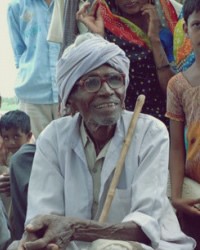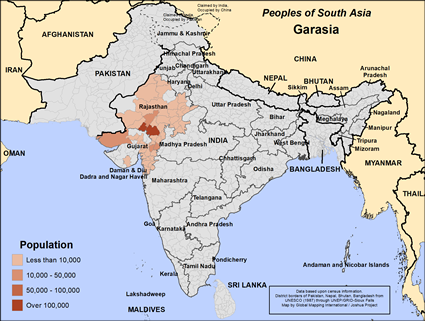The Rajput Garasia are the descendants of the Rajput who married Bhil women. They originally were chiefs who were driven from their wealth by invaders. During the thirteenth century, many poor Rajput fled to the Vindhya and Aravalli hills where they mixed with the Bhil settlers. In time, the Garasia defeated the Bhil chiefs and their followers, settling near the foothills and in the forests. There they were given land for cultivation as a reward for protecting the people and the area. The name "Garasia" refers to the Rajput and other landholders living in the Gujarat and Rajasthan regions.
Their language, known as Dungri Garasia, is an Indo-Aryan language belonging to the Bhil sub-group. Although they are related to the Bhil, the Rajput belong to a higher caste (social class) and dislike being referred to as a Bhil tribe.
Most live in India's western states of Gujarat and Rajasthan, but some are further west in Pakistan. Those in Pakistan speak Dhatki rather than Garasia.
Among the Rajput Garasia, the average land holding is small; therefore, the man of the household is able to do all of the work himself. Maize is the staple food grown by all families. Many also depend on forest produce as a means of support. The people are generally vegetarians and are no longer addicted to alcohol like other Bhil tribes.
The Rajput Garasia typically live in one-room houses made with mud and bamboo walls. Those with more money build flat tiled roofs, while the poorer people still use thatch. Houses are usually built on the slopes of hills with their fields extending out in front. There is usually a guest house opposite the house of the headman of the village. There is no central village site where the people meet together. In fact, there is very little unity or cooperation between the village clans.
Their women are not allowed to own property and are required to wear veils over their faces when in the presence of elder male relatives. Ironically, however, they are not considered inferior to men. The women's responsibilities include cooking, tending to the cattle, milking the animals, and looking after the children. The men do the physical labor such as plowing, harvesting, and building the houses.
The Garasia are allowed complete freedom in choosing a spouse. Men between the ages of 18 and 24 usually marry girls that are between the ages of 14 and 18. The two live together without any official marriage ceremony, although this may vary in some regions due to Hindu influence. The Garasia have a "joint family system" in which the sons remain with their families until their own children become adults. Intermarriage with other Bhil tribes is permitted, but cross-cousin marriages are strictly forbidden. A man is allowed to have more than one wife, if his first wife is either infertile or bears him no sons.
The Garasia believe that widows bring bad luck to the villagers. Although it is now illegal, some widows will sacrifice themselves in fire for the sake of the villagers. The community then commemorates her noble decision to end her life.
The women love to dress with many silver ornaments. They usually wear black or red blouses with large petticoats. The men are noted for their red or white turbans. Both men and women wear tattoos.
Today, they practice ethnic religions, but these beliefs have been heavily influenced by Hinduism. They might worship any Hindu gods along with their original belief in spirits, fearing ghosts, spirits of the dead, and black magic.
Only a few have put their faith in Christ alone. More laborers are needed to live and work among these precious people.
Ask the Lord to call people who are willing to go to Pakistan and share Christ with the Garasia.
Pray for God to raise up prayer teams who will begin breaking up the soil through worship and intercession.
Ask God to give Pakistani believers boldness to share Christ with Garasia people.
Ask the Holy Spirit to move in such a way that there is a disciple making movement among the Garasia people.
Scripture Prayers for the Garasia in Pakistan.
| Profile Source: Joshua Project |











